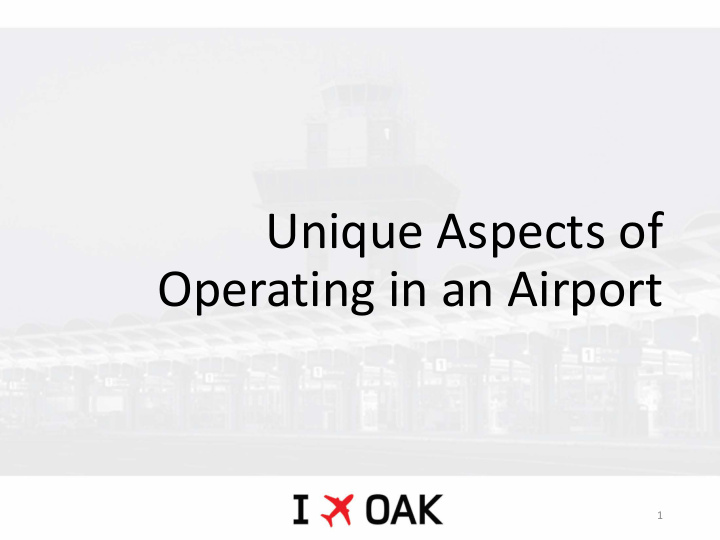



Unique Aspects of Operating in an Airport 1
Operating a Business in an Airport . . . It’s nothing like operating your business on the street! 2
Operating Days and Hours • ALL food and beverage units must be open 7 days per week, 365 days per year • No closures for holidays • Operating hours can start as early as 3:30 am - 4:00 am • Units must be open 90 minutes prior to the first departing flight in the morning • Units stay open until the last flight leaves from the terminal, no matter the hour • Units may have to stay open late due to flight delays caused by weather, aircraft mechanical, etc. 3
Passengers • Departing passengers (enplaning passengers) are the operators’ customers • Arrive at airport 60 to 90 minutes before departing flight • Airports are stressful to most passengers – passengers prefer to dine and shop once through security screening • Majority of concessions are located post-security 4
Passenger Preferences What They Look For • Variety of dining options • Full service dining • Quick serve/Fast casual • Grab and go • Quick and efficient service • Tech-savy operators; online ordering capabilities • To-go containers - environmentally friendly, easy to carry-on flight • Price/value – passengers still believe they are being over-charged at airports 5
Passenger Preferences Types of Food and Beverages • Variety of food options • Sandwiches • Salads • Burgers • Healthy and vegan • Ethnic Foods • Variety of Beverage options • Bottled water • Coffee • Juices, vitamin water, energy drinks, sodas, and other non-alcoholic beverages • Craft beers and whiskeys, wine • Other alcoholic drinks Note: Alcoholic beverages in open containers must be consumed on-premises where purchased, and can not consumed in other areas of the terminal or taken on-board a flight. 6
Employees • All employees must be badged and go through a 10-year FBI background check • Employees park in designated lots/spaces, not at the terminal • On-going staffing considerations • Early morning and late evening shifts • Peak periods during the day • Seasonal fluctuations • Receiving and stocking inventory • Training and management programs • There should be sufficient employees on-call at all times for emergency situations • Add staff during flight delays • Relieve staff during emergency situations • Replenish stock 7
Employee Retention and Labor Peace Assurance • Operator required to offer employment to employees of the prior tenant for a period of 90 days – Airport’s Worker Retention Policy • In order to submit a Proposal, the Proposer must return and sign the Proposal Form which contains the following: “Proposer acknowledges and agrees that it will comply with the Labor Peace Assurance provision of the Space/Use Permit as required by Board Resolution No 17- 35 and acknowledges that if selected, it must enter into a labor peace agreement within 30 days of a request by a labor organization prior to signing the Space/Use Permit.” 8
Use of Space • Units are small, little room for storage and support functions • Limited space at the Airport for storage and support, tenants will be charged a fee • May require space off-airport • Logistics Plan – replenishing inventory on a daily basis and during emergencies 9
Financial Considerations – Proposed Rent Rent is the greater of: • Minimum Annual Guarantee (MAG), or • Percentage rent MAG is established by OAK based on size of unit For example, a unit 1,000 SF in size would have a MAG of $200,000 (1,000 SF x $200/SF) Percentage Rent established by OAK Food and Non-Alcoholic Beverages = 13% of Gross Sales Alcoholic Beverages = 16% of Gross Sales 10
Financial Considerations Example of Rent Calculation Assume: Lease Space = 1,000 square feet (SF) Gross Sales = $1,750,000 Food and Non-Alcoholic Beverages = $1,400,000 Alcoholic Beverages = $350,000 Operator Pays Greater of MAG or Percentage Rent: MAG = $200,000 $200/SF x 1,000 SF = $200,000 Percentage Rent = $214,000 $1,400,000 x 13% = $182,000 $200,000 x 16% = $32,000 Operator’s Annual Rent Payment = $214,000 11
Financial Considerations (cont’d) Proposed Marketing Fee and Capital Investment • Marketing Fee = 0.5% of Gross Sales • Gross Sales = $1,750,000 * 0.5% or $8,750 Marketing Fee • Capital Investment: Minimum $450 per square foot • 1,000 SF would require an initial minimum investment of $450,000 • Mid-Term Capital Investment = $150/SF • 1,000 SF would require a minimum investment of $150,000 in Year 5 12
Financial Considerations (cont’d) • Performance Deposit in the form of a Cashier’s Check or Letter of Credit (LOC) = Six Months MAG Example: MAG for 1,500 SF = $200,000 Performance deposit = $200,000 x 50% = $100,000 • Proposal Deposit in the form of a Cashier’s Check - $50,000 per package 13
Develop Business Plan Ten-Year Plan • Develop ten-year sales projections • Determine cost of goods sold • Estimate operating expenses • Employee wages and benefits • License/franchise fees • Rent to the airport • Marketing fee • Repairs and maintenance • Administrative and management fees • Annual Operating Cash Flow to recover capital investment • Determine funding sources for capital investment • Calculate rate of return on investment 14
Ways to Participate at OAK • Prime Operator • Subtenant to a Prime Operator • Joint Venture Partner to a Prime Operator • Supplier of Goods and Services 15
Why Businesses Succeed at Airports? • Have well-trained and paid staff • Provide excellent customer service • Understand their customer • Are up-to-date on trends • Provide exceptional value for the price 16
Questions 17
Recommend
More recommend